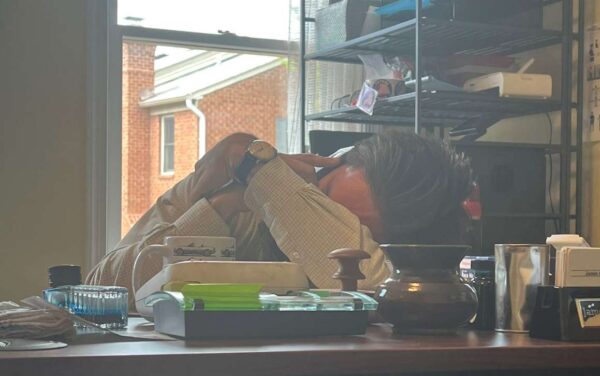This sponsored column is by Law Office of James Montana PLLC. All questions about it should be directed to James Montana, Esq., Doran Shemin, Esq., and Laura Lorenzo, Esq., practicing attorneys at The Law Office of James Montana PLLC, an immigration-focused law firm located in Arlington, Virginia. The legal information given here is general in nature. If you want legal advice, contact us for an appointment.
Note: this column was written by James Montana, who owns our little law practice. The opinions expressed therein are his own.
Your local lawyer, on the phone, either asking for a loan or making his next appointment for Guy Fieri-style frosted tips. Photo via Doran M. Shemin.
Whenever I walk into a business, I find myself musing, like Admiral Stockdale: Who am I? Why am I here? After I vault those philosophical hurdles, though, I usually find myself wondering: Am I getting a good deal? That is an important question, and the purpose of this column is to answer that question for you. Doing so, I hope, will give you a little insight into the finances of a local law practice.
The balance sheet has two sides: revenue and expenses. Revenue is determined by caseload and price. Outside of our corporate immigration work, we charge flat fees, and fees range from $300 for a work permit to $5,000 for deportation defense. The three lawyers here typically carry a caseload of between 100 and 150 cases. Does that mean that, at (say) 100 cases, and (say) $3,000 per case, a lawyer here generates $300,000 per year? Certainly not. Most immigration cases take more than a year to get to the finish line. Court cases sometimes take more than a decade. So, managing our revenue means taking the long view. If we think we can’t carry the load in 2023, 2024, or 2025, we turn down the money today.
Balancing our need for revenue with our professional obligation to keep cases at a manageable level is tricky. We try to keep fees low and client numbers up. Given those commitments, a good rainmaker might generate fees in the very low six figures.
Let’s turn to (perhaps) the more interesting side of the balance sheet: Where does that money go?
The largest expense by far is salaries. I don’t want to disclose lawyer salaries to the entire internet, but you can fairly infer from (1) gross revenue described above, and (2) the expenses described below that (3) we are not chuckling all the way to our third homes in Cancun.
We spend about $20,000 in rent, utilities and maintenance each year. (That’s low — we squeeze three lawyers into 500 square feet, and when we need something fixed, I buy the supplies at Ayers Hardware.)
We spend about $10,000 per year on paper, toner, free coffee for the clients and other office supplies.
We pay about $20,000 per year for a remote reception service. Our friends at Ruby Receptionists answer calls for twelve hours a day, five days per week, in English and Spanish, and are worth even that extraordinary number of pennies. Picking up the phone is an important part of our work.
We spend about $8,000 per year in postage. (13,793 first-class stamps? No, not really. We ship almost all of our correspondence to the government by Priority Mail or Certified Mail because, with all due respect to our friends at USCIS, we trust-but-verify all shipments to the immigration authorities.)
We spend about $12,000 per year on payroll management, workers’ compensation and bookkeeping services, and, when you roll in the cost of our practice management software, business insurance and malpractice insurance, you get to about $20,000.
Health insurance for our three lawyers — we cover 70% of the cost, for both workers and dependents — costs a neat $20,000 per year.
Amidst some other odds and ends, we have a small advertising budget, most of which goes to our friends at ARLnow. No, we won’t tell you how much. But it’s money well spent!
Do you have questions about the economics of law practice? Are you thinking of starting your own law practice? We want more people to work in our field, and we’re happy to mentor anyone who is thinking of giving it a try. And, as always, we welcome comments and will reply to all that we can.



